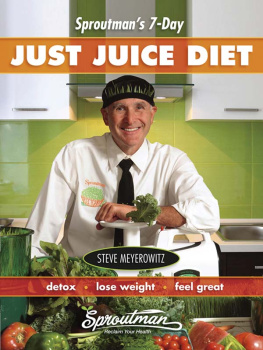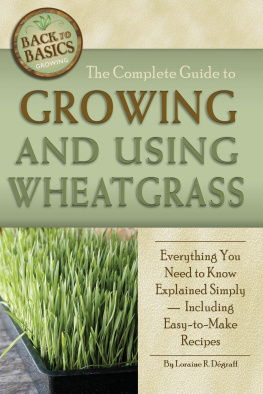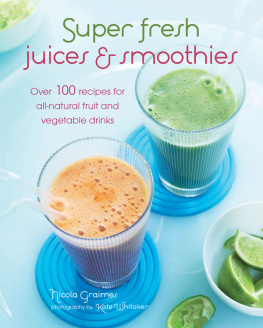Wheatgrass
Natures Finest
Medicine
Revised Edition
by Steve Meyerowitz
Cleanse  Nourish
Nourish  Rejuvenate
Rejuvenate  Heal
Heal
Wheatgrass

Natures Finest
Medicine
The Complete Guide to Using Grass
Foods & Juices to Help Your Health
Revised Edition
by Steve Meyerowitz

Newly Revised and Expanded
SEVENTH EDITION
Copyright 2006 by Steve Meyerowitz
Original Copyrights 1983, 1987, 1990, 1991, 1998, 1999
Printed in the United States of America.
ISBN 978-1-878736-98-7 Paperback
All rights reserved. No part may be reproduced by electronic, photocopy, facsimile or any other means without prior permission.
Library of Congress Cataloging-in-Publication Data
Meyerowitz, Steve.
Wheatgrass : natures finest medicine : the complete guide to using grass foods & juices to help your health / by Steve Meyerowitz. 7th ed.
p. cm.
Includes bibliographical references and index.
ISBN-13: 978-1-878736-98-7 (pbk.)
1. Wheatgrass (Wheat)Therapeutic use. 2. Vegetable juicesTherapeutic use. 3. Raw foodsTherapeutic use. I. Title.
RM255.M49 2006
613.2'6dc22
2006022042
Special thanks to the Intl Biogenic Society for permission to extract from the Essene Gospel of Peace by E.B. Szekely. And to the Ann Wigmore Foundation for permission to use her words in the Epilogue. Cover photo by Kenneth Crawford, courtesy of Pines International.
Sproutman Publications
PO Box 1100, Great Barrington, Mass. 01230
413-528-5200 Fax 413-528-5201
Distributed by
Book Publishing Company
PO Box 99, Summertown, TN 38483
888-260-8458. 931-964-3571 Fax 931-964-3518
Table of Contents
Table of Contents
by Subject
Dedicated to
Charles F. Schnabel

Dr. Charles F. Schnabel
The Father of Wheat Grass
18951974
In 1930, Charles F. Schnabel started eating grass. Before anyone else, he initiated a movement to promote the human consumption of grass. He dedicated his entire life to the nutritional and health benefits of grass. He also furthered its role as a premium livestock feed and as a profitable and ecological crop for American farmers. His dream was to see grass included as a valuable supplement to the American diet. He knew from his experiments with animals and his research in the laboratory, that it would boost our nutrition, build good blood, and strengthen our immunity against disease. His vision was of a grassrich America that would donate tons of grass worldwide to feed the hungry and provide a model for malnourished countries to follow. He is a forgotten hero, but he is remembered in these pages for how close he came to making wheat grass a household food. Few people today are aware of it, but in the 1940s, consumers all over America and Canada could purchase cans of grass in their local pharmacies. Stories about the human consumption of grass appeared in magazines such as Newsweek, Business Week, and Time. Today, grass is only now approaching the level of popularity that Charles Schnabel had crusaded for and achieved over sixty years ago.
This book is dedicated to Dr. Charles F. Schnabels lifelong and tireless efforts to promote the benefits of grass as a nutritious food. May his dreams come true.
A Wheatgrass Primer
What is Wheatgrass?
Wheatgrass is a variety of grass that is used like an herbal medicine for its therapeutic and nutritional properties. It is available as a fresh squeezed juice, a dried juice concentrate, an extract, a whole leaf powder, or tablets. This book uses the name wheat grass because it is the most popular, but the common grains of barley, oat and Kamut grow grasses that are equally potent. See Spiritual & Religious Roots, History & Culture, Healing with Grass, Nutrition, The Pioneers, Real Stories from Real People.
What does it do?
It has broad effectiveness, but its three most therapeutic roles are: blood purification, liver detoxification, and colon cleansing. As a food it is very nourishing and restorative with such a complete range of nutrients that it can, by itself, sustain life. This nutritional miracle is most evident in the animal kingdom where studies prove large and small grazing animals not only sustain themselves on young grasses but also improve their health. See Healing with Grass, Nutrition, Research, Real Stories from Real People, Spiritual & Religious Roots.
How do I take it?
For therapeutic purposes, you need to take a minimum of six to ten ounces of fresh juice daily or the equivalent in powder. You can also take it rectally through enemas or implants. For nutrition and prevention, you can make powdered drinks or take tablets. See The Juicers, Healing with Grass, Real Stories from Real People.
Where do I get it?
From your natural food store, juice bar, direct from growers, or mail order. See Resources, The Companies, The Pioneers, Wheatgrass Retreats.
Why should I take it?
Wheatgrass earned its reputation from people with terminal illnesses who took it at the eleventh hour of their lives, after conventional medicine left them with no hope. But you can take it as part of a long range prevention and health maintenance program. See Healing with Grass, Research, Nutrition, Real Stories from Real People.
How do I get started?
You can grow the grass yourself, buy it from a grower or health food store, drink the juice at a juice bar or buy bottled grass tablets and powders. But if you are sick, it is highly recommended that you enroll in a wellness program at a wheatgrass retreat center. As an alternative, you can establish a home-health program using the information in this book and the guidance of a knowledgeable health professional. See Grow Your Own Grass, The Juicers, The Companies, Wheatgrass Retreats.
Why should I believe you?
There are many scientific studies demonstrating the efficacy and nutrition of grasses. Most information about its therapeutic effectiveness is based on clinical evidence and the word-of-mouth testimony of users. See Science & Wheatgrass, Research, Real Stories from Real People, Nutrition, Spiritual & Religious Roots, History & Culture.
Wheat Grass vs. Wheatgrass
A word on spelling. Wheat grass is a variety of grass like barley, oats and rye, grown in open fields. Wheatgrass refers to the product typically grown indoors in trays and the juice consumed for health maintenance or disease treatment.
Next page











 Nourish
Nourish 

